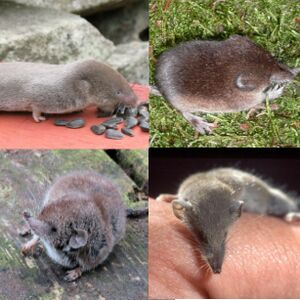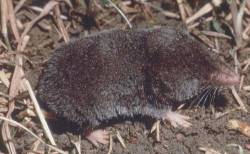زباب
| الزباب Shrews[1] | |
|---|---|

| |
| زباب جنوبي قصير الذيل | |
| التصنيف العلمي | |
| مملكة: | |
| Phylum: | |
| Class: | |
| Order: | |
| Family: | Soricidae G. Fischer, 1814
|
| Type genus | |
| Sorex | |
| Subfamilies | |
الزباب أو فأر الزباب أو الفويسقة Shrew ، من عائلة Soricidae، هو حيوان ثديي صغير من رتبة آكلات الحشرات. وهو small mole-like mammals classified in the order Eulipotyphla. True shrews are not to be confused with treeshrews, otter shrews, elephant shrews, West Indies shrews, or marsupial shrews, which belong to different families or orders.
Although its external appearance is generally that of a long-nosed mouse, a shrew is not a rodent, as mice are. It is, in fact, a much closer relative of hedgehogs and moles; shrews are related to rodents only in that both belong to the Boreoeutheria magnorder. Shrews have sharp, spike-like teeth, whereas rodents have gnawing front incisor teeth.
Shrews are distributed almost worldwide. Among the major tropical and temperate land masses, only New Guinea, Australia, New Zealand, and South America have no native shrews. However, as a result of the Great American Interchange, South America does have a relatively recently naturalised population, present only in the northern Andes.
The shrew family has 385 known species, making it the fourth-most species-diverse mammal family. The only mammal families with more species are the muroid rodent families (Muridae and Cricetidae) and the bat family Vespertilionidae. The shrew family also probably has the largest population of any mammal family: there are an estimated 100 billion shrews in the world, with an average of a few shrews per hectare of forest.[2]
السمات
الزباب هو حيوان صغير يشبه الجرذ، له أنف طويل وحاد. يصنف بعض هذه الحيوانات ضمن أصغر الثدييات المعروفة حجمًا، حيث يبلغ وزن بعضها جرامين فقط. وتعيش هذه الحيوانات في كل من نصف الكرة الأرضية الشرقي والغربي، وتقيم مساكنها في الحقول، وفي الغابات والحدائق والمستنقعات. [3] ودائمًا ما يخلط المرء بين الزبابات والجرذان نتيجة لصغر حجمها. وللزباب أنف طويل ونحيل يقوم بتحريكه لتقصي الثقوب والشقوق الصغيرة بحثًا عن الطعام. والعينان والأذنان صغيرتان جدًا، والجسم مُغطَّى بشعر قصير أسود اللون. ومن أكبر الزباب حجمًا زباب الغابات الإفريقية، والذي يبلغ طوله 29 سم. ويعيش أصغر أنواع الزباب في أفريقيا أيضًا، وهو الزباب القزم ذو الأسنان البيضاء، والذي يبلغ طوله 4,5 سم فقط.
The largest species is the Asian house shrew (Suncus murinus) of tropical Asia, which is about 15 cm (6 in) long and weighs around 100 g (3+1⁄2 oz)[4] The Etruscan shrew (Suncus etruscus), at about 3.5 cm (1+3⁄8 in) and 1.8 غرام (28 حبة), is the smallest known living terrestrial mammal.
In general, shrews are terrestrial creatures that forage for seeds, insects, nuts, worms, and a variety of other foods in leaf litter and dense vegetation. e.g. grass, but some specialise in climbing trees, living underground, living under snow, or even hunting in water. They have small eyes and generally poor vision, but have excellent senses of hearing and smell.[5] They are very active animals, with voracious appetites. Shrews have unusually high metabolic rates, above that expected in comparable small mammals.[6] For this reason, they need to eat almost constantly like moles. Shrews in captivity can eat 1⁄2 to 2 times their own body weight in food daily.[7]
They do not hibernate, but some species are capable of entering torpor. In winter, many species undergo morphological changes that drastically reduce their body weight. Shrews can lose between 30% and 50% of their body weight, shrinking the size of bones, skull, and internal organs.[8]
Whereas rodents have gnawing incisors that grow throughout life, the teeth of shrews wear down throughout life, a problem made more extreme because they lose their milk teeth before birth, so have only one set of teeth throughout their lifetimes. In some species, exposed areas of the teeth are dark red due to the presence of iron in the tooth enamel. The iron reinforces the surfaces that are exposed to the most stress, which helps prolong the life of the teeth. This adaptation is not found in species with lower metabolism, which don't have to eat as much and therefore don't wear down the enamel to the same degree. The only other mammals’ teeth with pigmented enamel are the incisors of rodents.[9] Apart from the first pair of incisors, which are long and sharp, and the chewing molars at the back of the mouth, the teeth of shrews are small and peg-like, and may be reduced in number. The dental formula of shrews is:3.1.1-3.31-2.0-1.1.3
Shrews are fiercely territorial, driving off rivals, and coming together only to mate. Many species dig burrows for catching food and hiding from predators, although this is not universal.[5]
Female shrews can have up to 10 litters a year; in the tropics, they breed all year round; in temperate zones, they cease breeding only in the winter. Shrews have gestation periods of 17–32 days. The female often becomes pregnant within a day or so of giving birth, and lactates during her pregnancy, weaning one litter as the next is born.[5] Shrews live 12 to 30 months.[10]
Shrews are unusual among mammals in a number of respects. Unlike most mammals, some species of shrews are venomous. Shrew venom is not conducted into the wound by fangs, but by grooves in the teeth. The venom contains various compounds, and the contents of the venom glands of the American short-tailed shrew are sufficient to kill 200 mice by intravenous injection. One chemical extracted from shrew venom may be potentially useful in the treatment of high blood pressure, while another compound may be useful in the treatment of some neuromuscular diseases and migraines.[11][مطلوب مصدر أفضل] The saliva of the northern short-tailed shrew (Blarina brevicauda) contains soricidin, a peptide which has been studied for use in treating ovarian cancer.[12] Also, along with the bats and toothed whales, some species of shrews use echolocation.[13] Unlike most other mammals, shrews lack zygomatic bones (also called the jugals), so have incomplete zygomatic arches.[14]
تحديد الموقع بالصدى
The only terrestrial mammals known to echolocate are two genera (Sorex and Blarina) of shrews, the tenrecs of Madagascar, bats, and the solenodons.[15] These include the Eurasian or common shrew (Sorex araneus) and the American vagrant shrew (Sorex vagrans) and northern short-tailed shrew (Blarina brevicauda). These shrews emit series of ultrasonic squeaks.[16][17] By nature the shrew sounds, unlike those of bats, are low-amplitude, broadband, multiharmonic, and frequency modulated.[17] They contain no "echolocation clicks" with reverberations and would seem to be used for simple, close-range spatial orientation. In contrast to bats, shrews use echolocation only to investigate their habitats rather than additionally to pinpoint food.[17]
Except for large and thus strongly reflecting objects, such as a big stone or tree trunk, they probably are not able to disentangle echo scenes, but rather derive information on habitat type from the overall call reverberations. This might be comparable to human hearing whether one calls into a beech forest or into a reverberant wine cellar.[17]
التغذية
يتغذى الزباب بصفة رئيسية بالحشرات والديدان ولكنه يقتل أحيانًا بعض الطيور ويتغذى بها، كما أنه يتغذى أيضًا ببعض الكائنات الحية الصغيرة الأخرى. والزبابة تهاجم الجرذان التي تكبرها حجمًا وتقاتلها بشراسة. وعضة بعض الزباب لفريستها تكون سامة. وينبغي على الزباب أن يأكل في الغالب بصفة مستمرة خلال النهار لتلبية متطلبات الجهد الكبير الذي يبذله.
تتغذى حيوانات الرغوب والثعالب والبومة بالزباب، غير أن رائحة المسك النفاذة التي تصدر عنه تحميه من أعدائه. وتقوم أنواع متعددة من الزباب بعمل حفر لحماية نفسها. ويقوم الزباب الأوروبي الذي يعيش في الماء باستخدام الحفر لنفض المياه عن فروته.
والزباب لا يلحق الضرر بالإنسان، كما أنه مفيد في الحدائق لأنه يتغذى بالحشرات والديدان الصغيرة.
التصنيف
- فصيلة الزباب
- تحت فصيلة Crocidurinae
- تحت فصيلة Myosoricinae
- تحت فصيلة Soricinae
- قبيلة Anourosoricini
- قبيلة Blarinellini
- قبيلة Blarinini
- قبيلة Nectogalini
- قبيلة Notiosoricini
- قبيلة Soricini
المصادر
- ^ قالب:MSW3 Hutterer
- ^ Kurta, Allen (1995). Mammals of the Great Lakes Region. Ann Arbor, MI: The University of Michigan Press. pp. 46–49. ISBN 978-0-472-06497-7.
- ^ الموسوعة المعرفية الشاملة
- ^ Louch CD, Ghosh AK, Pal BC (1966). "Seasonal Changes in Weight and Reproductive Activity of Suncus murinus in West Bengal, India". Journal of Mammalogy. 47 (1): 73–78. doi:10.2307/1378070. JSTOR 1378070. PMID 5905563.
- ^ أ ب ت Barnard CJ (1984). Macdonald DW (ed.). The Encyclopedia of Mammals. New York: Facts on File. pp. 758–763. ISBN 0-87196-871-1.
- ^ William J, Platt WJ (1974). "Metabolic Rates of Short-Tailed Shrews". Physiological Zoology. 47 (2): 75–90. doi:10.1086/physzool.47.2.30155625. JSTOR 30155625. S2CID 87675441.
- ^ Reid F (2009). A Field Guide to the Mammals of Central America and Southeast Mexico. pp. 63–64.
- ^ Churchfield S (January 1990). The natural history of shrews. Cornell University Press. ISBN 978-0-8014-2595-0.
- ^ Wible J (6 February 2018). "Why Do Some Shrews Have Dark Red Teeth?". Carnegie Museum.
- ^ Macdonald DW, ed. (2006). The Encyclopedia of Mammals. Oxford University Press. ISBN 0-19-920608-2.
- ^ Piper, Ross (30 August 2007). Extraordinary Animals: An Encyclopedia of Curious and Unusual Animals. Greenwood Press. ISBN 978-0313339226.
- ^ "BioProspecting NB, Inc's novel ovarian cancer treatment found effective in animal cancer model". 8 Apr 2009. Archived from the original on 16 July 2011. Retrieved 23 May 2010.
- ^ Chai, Simin; Tian, Ran; Rong, Xinghua; Li, Guiting; Chen, Bingyao; Ren, Wenhua; Xu, Shixia; Yang, Guang (2020-02-25). "Evidence of Echolocation in the Common Shrew from Molecular Convergence with Other Echolocating Mammals". Zoological Studies. 59 (59): e4. doi:10.6620/ZS.2020.59-04. ISSN 1021-5506. PMC 7262541. PMID 32494297. S2CID 215414310.
- ^ "About the mammalian skull, and be able to define and/or identify on a specimen all underlined terms" (PDF).
- ^ "What is echolocation and which animals use it?". Discover Wildlife (in الإنجليزية). Retrieved 2022-03-25.
- ^ Tomasi TE (1979). "Echolocation by the Short-Tailed Shrew Blarina brevicauda". Journal of Mammalogy. 60 (4): 751–9. doi:10.2307/1380190. JSTOR 1380190.
- ^ أ ب ت ث Siemers BM, Schauermann G, Turni H, von Merten S (October 2009). "Why do shrews twitter? Communication or simple echo-based orientation". Biology Letters. 5 (5): 593–6. doi:10.1098/rsbl.2009.0378. PMC 2781971. PMID 19535367.
- Buchler, E.R. 1973. The use of echolocation by the wandering shrew, Sorex vagrans Baird. Diss. Abstr. Int. B. Sci. Eng. 33(7): 3380-3381.
- Buchler, E.R. 1976. Experimental demonstration of echolocation by the wandering shrew (Sorex vagrans). Anim. Behav. 24(4): 858-873.
- Busnel, R.-G. (Ed.). 1963. Acoustic Behaviour of Animals. Amsterdam: Elsevier Publishing Company.
- Forsman, K.A., Malmquist, M.G. 1988. Evidence for echolocation in the common shrew, Sorex araneus. J. Zool., Lond. 216 (4): 655-663. .
- Gould, E. 1962. Evidence for echolocation in shrews.Ph.D. Thesis, Tulane University.
- Gould, E., Negus, N., Novick, A. 1964. Evidence for echolocation in shrews. J. Exp. Zool. 156: 19-38.
- Hutterer, R. 1976. Deskriptive und vergleichende Verhaltensstudien an der Zwergspitzmaus, Sorex minutus L., und der Waldspitzmaus, Sorex araneus L. (Soricidae - Insectivora - Mammalia). Unpublished Ph.D. Thesis, Univ. Wien.
- Hutterer, R., Vogel., P. 1977. Abwehrlaute afrikanischer Spitzmäuse der Gattung Crocidura Wagler, 1832 und ihre systematische Bedeutung. Bonn. Zool. Beitr. 28(3/4): 218-227.
- Hutterer, R., Vogel, P., Frey, H., Genoud, M. 1979. Vocalization of the shrews Suncus etruscus and Crocidura russula during normothermia and torpor. Acta Theriol. 24(21): 267-271.
- Irwin, D.V., Baxter, R.M. 1980. Evidence against the use of echolocation by Crocidura f. flavescens (Soricidae). Säugetierk. Mitt. 28(4): 323.
- Kahmann, H., Ostermann, K. 1951. Wahrnehmen und Hervorbringen hoher Töne bei kleinen Säugetieren. Experientia 7(7): 268-269.
- Köhler, D., Wallschläger, D. 1987. Über die Lautäußerungen der Wasserspitzmaus, Neomys fodiens (Insectivora: Soricidae). Zool. Jb. Physiol. 91: 89-99.
- Sales, G., Pye, D. 1974. Ultrasonic communication by animals. London.
- Tomasi, T.E. 1979. Echolocation by the short-tailed shrew Blarina brevicauda. J. Mammalogy 60(4): 751-759.
وصلات خارجية
| Soricidae
]].